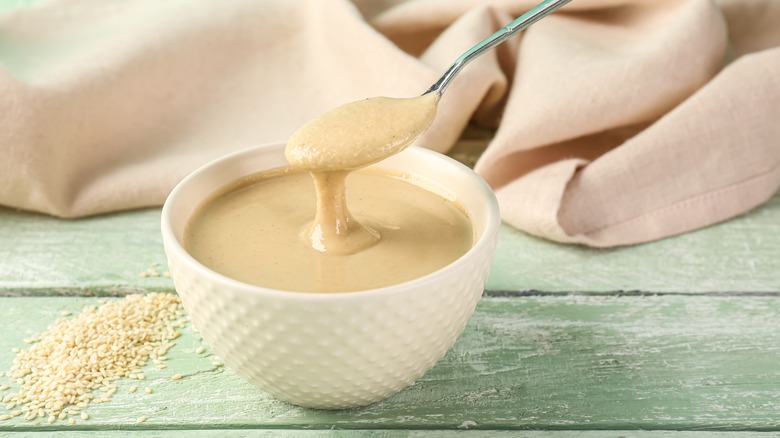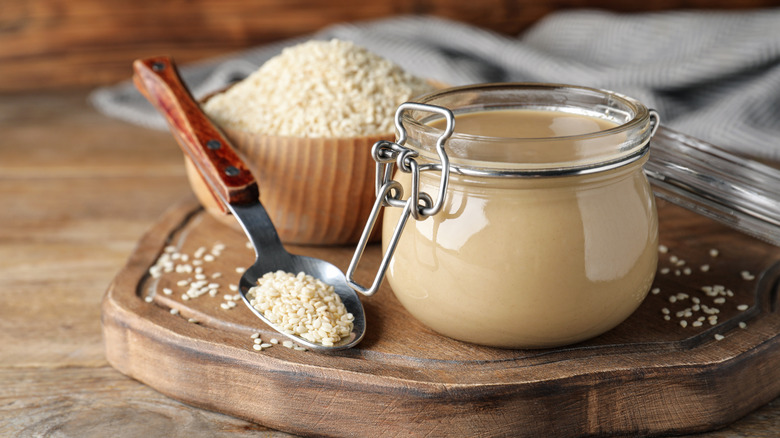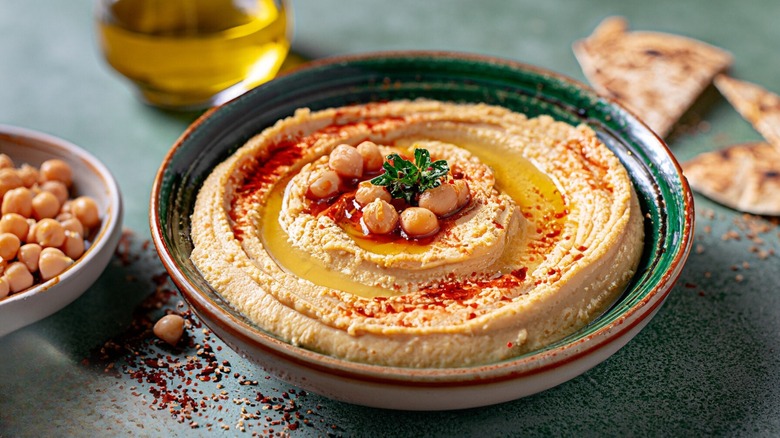How Long Tahini Lasts Once Opened
Tahini is essential for cooking up some delicious Middle Eastern dishes. The sesame paste is the star of the show when blending up some hummus or baba ghanoush, but it can also be drizzled as-is on top of a Greek pita pizza. Fortunately, if you aren't using it all right away, tahini can last for quite a while. Unopened, some brands boast a shelf life of up to two years — though it is always important to adhere to the jar's expiration date.
Even after the jar's seal has been broken, so long as the tahini has been stored properly, it can last between six to eight months. Its long lifespan is thanks to the natural oils from the sesame seeds acting as a preservative. However, tahini made from shelled sesame seeds will last a little longer than intact varieties because the seeds contain more antioxidants, which protect the paste from spoilage.
Although the sauce doesn't necessarily require refrigeration, keeping tahini cold can prevent it from separating prematurely. This may thicken the sauce slightly, but a quick mix will loosen things up again. For the best chances of preserving the tahini's freshness, it should be stored in an airtight container. Any moisture creeping in will cause the tahini to clump up and take on an unpleasant texture.
Homemade tahini won't last as long as store-bought brands, however. So if you're planning on blending up a batch of your own, you'll want to use it within six months.
How to tell if tahini is still good
Of course, if you've had a jar of tahini for a while, it's always best to check for any signs that the sauce is past its prime. Any strange smells, off-putting tastes, or weird textures are signs that it's likely gone bad and should be discarded. While sesame seeds can taste slightly bitter when blended into fresh tahini, overwhelmingly sour or metallic flavors are likely a sign of spoilage. And, of course, any visible mold or odd discoloration is an automatic sign that the entire jar should be tossed in the trash.
If you want to extend the lifespan of your tahini even further, it can be frozen. It will need to be transferred to freezer-safe storage, like a freezer bag or a plastic container. It can even be separated into smaller batches to defrost a little at a time. Be sure to leave some extra room to account for expansion as the paste freezes. Then, it can be placed in the freezer for up to a year. Any longer than six to 12 months, however, may impact the flavor of the sauce, so it's best to enjoy it as soon as possible. To thaw the tahini, leave it in the refrigerator overnight, then stir it until it reaches the correct consistency.
How to use leftover tahini
Hummus and baba ghanoush are, of course, the spreads that tahini is most often associated with. Aside from the chickpea- and eggplant-based dips, though, it can lend its flavor to plenty of other dishes for a little bit of a health boost. The sauce contains antioxidants known as lignans, which could help to prevent tissue damage, heart disease, or cancer. It's also high in manganese, vitamins B1 and B6, and phosphorus.
Tahini can be used to thicken up soups or sauces, thanks to its high fat content. Its rich texture and flavor may lend itself best to creamy dishes, like nutty carrot and apple soup, or a savory beer cheese dip. It can also be spooned onto burgers, blended into smoothies, mixed into oatmeal, or used as a salad dressing.
When it's time to satisfy your sweet tooth, tahini can also be added into cake batter, or mixed into frosting. The underrated ingredient can amplify your baked goods, thanks to its slightly toasted, nutty palate. It can pair well with cookies or sweet bread recipes — particularly if the recipe calls for nuts to be added for a little bit of crunch. You may need to cut out a little oil from the recipe to account for tahini's fat content, but it will easily blend into plenty of batters to add in an extra dimension of flavor.



